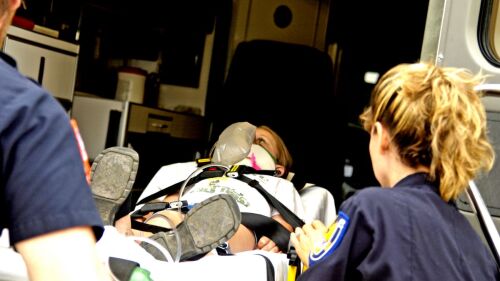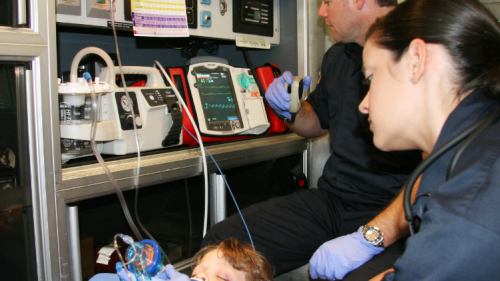BREAKING NEWS
A fire chief, police officer and race volunteer were killed in two separate incidents at the Hartshorne H-Town Throwdown
Local and state leaders gathered at Lafayette’s Emergency Operations Center to coordinate response strategies in a simulated school shooting at Acadiana Renaissance Academy
UNM Hospital nurses, staff say denied raises and noncompetitive pay worsen chronic understaffing and overcrowding, with capacity often at 105%–120%
Over 100 agencies ran preparedness exercises at Amon G. Carter Stadium and 14 other sites, testing communication and active-threat response ahead of FIFA World Cup crowds
Paramedic Abdur Rahman joined FDNY in 2002, served at EMS Stations 8, 16 and 13 before being promoted to paramedic in 2021, and was assigned to the Training Academy
EXCLUSIVES
SPECIAL REPORTS
UPCOMING & ON-DEMAND EVENTS
Understand causes and learn techniques to manage stress for on the job or at home
Fitch & Associates announced it will be holding its first-ever online leadership summit from July 27-29
Municipal services, non-profits and for-profits that partner with municipalities can apply through the FEMA Public Assistance Program
Learn how health information exchange is improving patient outcomes, increasing organizational efficiencies and recovering revenue as possible in the Pinnacle Webinar Series
The personal risks and magnitude of suffering with the pandemic are something no one should have to face alone
Documenting COVID-19 exposures with Mark43 can help command staff strategically deploy limited resources
Jay Fitch, PhD; and Jim Marshall, MA, share care strategies and how to recognize performance risk factors as part of the Pinnacle Webinar Series
Learn how Juvare can be a resource for tracking COVID-19 cases in real time
Learn how next-generation 911 will help responders navigate COVID-19
These new mitigation strategies help protect vulnerable people and prevent overwhelmed hospitals
The Center for Firefighter Injury Research & Safety Trends webinar will feature panelists discussing opportunities for strengthening EMS systems post-COVID-19
Identify the human factors – fatigue, stress, distraction – that can cause medical errors and change your organization’s culture
INDUSTRY INSIGHTS
Discover the benefits of hosting an au pair
These durable, ergonomic mounts help safeguard cardiac monitor investments and streamline the continuum of care
How lessons from COVID-19 are shaping the next evolution in PPE for law enforcement, fire, EMS and corrections
Lessons from agencies mastering real-time collaboration under pressure
Suppliers may be wary of sharing their stocks with new EMS programs, but this platform can help ensure they’re used right
OFF DUTY
Share your public safety pride with an ornament on your Christmas tree
Healthy, portable, delicious choices for quick fueling
Add on-the-go supplements, hydration and sleep aids to ward off winter illnesses
A letter penned by a military spouse helps explain Santa’s appearance on days other than Christmas for first responders and military members working the holiday
For first responders, mocktails offer a way to join in the festivities while staying sharp and ready for any call
Find answers to all your questions surrounding this five-day online shopping bonanza
These events provide first responders with a unique opportunity to connect with their communities, promote safety and foster goodwill beyond emergency response
Early deals are already live! Check them out today
From clever socks to statement mugs, we’ve got your quick-gift needs covered
With a few mindful swaps, you can enjoy the flavors of the season without the guilt – or the post-feast food coma
PRODUCT RESEARCH CATEGORIES
The Online Training product category features products and information for researching EMS online training and covering a variety of products and services, including training programs/courses available online.
Training simulators are key tools for building EMS skills through realistic, scenario-based learning. This topic covers high- and low-fidelity simulators used to practice airway management, trauma care, cardiac response, and other critical interventions. Simulators help EMS personnel improve decision-making, teamwork, and clinical performance in a controlled environment. They also support certification, recertification, and ongoing education. For additional resources used in EMS training, see Training Equipment & Supplies. Explore the articles in this topic to learn how simulators enhance the quality and effectiveness of EMS training programs.
The EMS1 EMS Automated CPR product category is a collection of products and information for researching Automated Cardiopulmonary Resuscitation (CPR) products. It covers a variety of Automated External Defibrillators (AEDs), training tools and other resuscitation products.
The EMS1 Capnography product category features products and information for researching capnography’s use by EMS personnel to aid in their assessment and treatment of patients in the prehospital environment. Click here to download a guide to normal/abnormal capnography waveforms.
The CPR & Resuscitation product category features products and information for researching Cardiopulmonary Resuscitation (CPR) products.
The EMS1 Patient Immobilization and Splints product category features products and information for researching EMS patient handling and immobilization equipment, covering various types of splints, backboards, patient handling, stretchers, and other tools for successful patient immobilization.
The EMS1 Vascular Access product category features information and resources on equipment used for vascular access for researching Vascular Access products, including intraosseous infusion systems.
The EMS1 Medical Equipment Services product category features information for researching EMS Medical Equipment Services, covering a variety of service programs and repair options for medical equipment.
The EMS1 Bleeding Control product category features products and information for researching Bleeding Control products by EMS personnel to aid in their assessment and treatment of patients in the prehospital environment.
The EMS1 Ambulance Disposable Supplies product category features information, product listings and resources for researching Ambulance Disposable Supplies.

















































